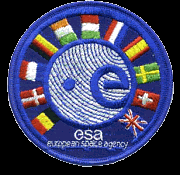European Space Agency (ESA) patch.
16 February 2017
Following the appearance of a large crack in the ice shelf close to the Halley VI research station in Antarctica, information from the Copernicus Sentinel-1 and Sentinel-2 satellites helped to decide to close the base temporarily.
Nourished by an inflow of ice from grounded glaciers and snow accumulating on its surface, Brunt Ice Shelf is a floating ice sheet in the Weddell Sea Sector of Antarctica. The floating ice moves steadily towards the ocean, where it occasionally calves off as icebergs.
Halloween Crack
Cracks often appear on shelves as the ice deforms. However, rapidly expanding cracks indicate impending calving.
Since the Halley VI base of the British Antarctic Survey was only 17 km from the crack that appeared last October, Enveo – a company that uses satellite data for cryosphere studies – and the Survey used radar images from Sentinel-1 and optical images from Sentinel-2 to monitor the situation.
Dubbed Halloween Crack, it was lengthening inland as fast as 600 m a day in November and December.
Halley was designed to be relocated if the ice becomes dangerous. In fact, it had already been moved 23 km inland during last Antarctica’s summer months because another ice chasm had begun to show signs of growth.
Recent Sentinels sequences revealed a complex picture that made it difficult to predict how the Halloween Crack would evolve, so the Survey decided to evacuate and shut the base for the coming winter as a precaution.
Relocating Halley station
Normally, around 70 people live and work at the base during the summer and fewer than 20 during the winter. However, this is the first winter that the base has been completely closed.
Thomas Nagler, Enveo CEO, said, “We get Sentinel-1 and Sentinel-2 data shortly after acquisition so we are able extract information on the crack’s progression and deliver this information to our Survey colleagues very quickly.”
Hilmar Gudmundsson, Survey lead scientist, added, “The frequency of Sentinel-2 images and Sentinel-1 radar products allows us to follow in detail and almost in real time the development of the crack as it grows week by week.
“This also provides us with essential information for ice-deformation models, leading to a deeper understanding of such events.”
The two Sentinel missions are being used to closely monitor three main aspects: Halloween Crack, which is now growing at about 200 m a day, two other ice chasms and detect new cracks.
Shelf deformation
Since November, Sentinel-2 has been programmed to acquire images at each overflight to maximise the chances of getting cloud-free images.
Sentinel-1A and Sentinel-1B have also been continually gathering data with two crossing tracks. This allows the rifts to be mapped showing how the ice shelf deforms at the tip of the growing crack.
Mark Drinkwater, head of ESA’s Earth observation mission, added “Routine Antarctic summer observations by the combination of Copernicus Sentinel-2A and Sentinel-1A and -1B are now demonstrating their value for monitoring rapid environmental change and providing information crucial to informed decisions on matters of safety and security in Antarctica.
Sentinel-1 monitoring motion
“Though without direct effect on Antarctic infrastructure, similarly dramatic summer development of ice-shelf fractures is revealed around Antarctica, notably Pine Island glacier in West Antarctica and the Larsen-C and Brunt ice shelves in the Weddell Sea.”
Antarctica will soon be facing the dark winter months. Importantly, Sentinel-1’s radar will continue to provide images so that these changes can be monitored.
Related links:
Sentinel-1: http://www.esa.int/Our_Activities/Observing_the_Earth/Copernicus/Sentinel-1
Sentinel-2: http://www.esa.int/Our_Activities/Observing_the_Earth/Copernicus/Sentinel-2
Sentinel data access & technical information: https://sentinels.copernicus.eu/web/sentinel/home
ENVEO: http://www.enveo.at/
British Antarctic Survey: https://www.bas.ac.uk/
Halley VI Research Station: https://www.bas.ac.uk/polar-operations/sites-and-facilities/facility/halley/
Journal of Glaciology:
Five decades of strong temporal variability in the flow of Brunt Ice Shelf: https://doi.org/10.1017/jog.2016.132
Animation, Images, Video, Text, Credits: ESA/contains modified Copernicus Sentinel data (2016–17), processed by ENVEO/British Antarctic Survey/ATG medialab.
Best regards, Orbiter.ch




